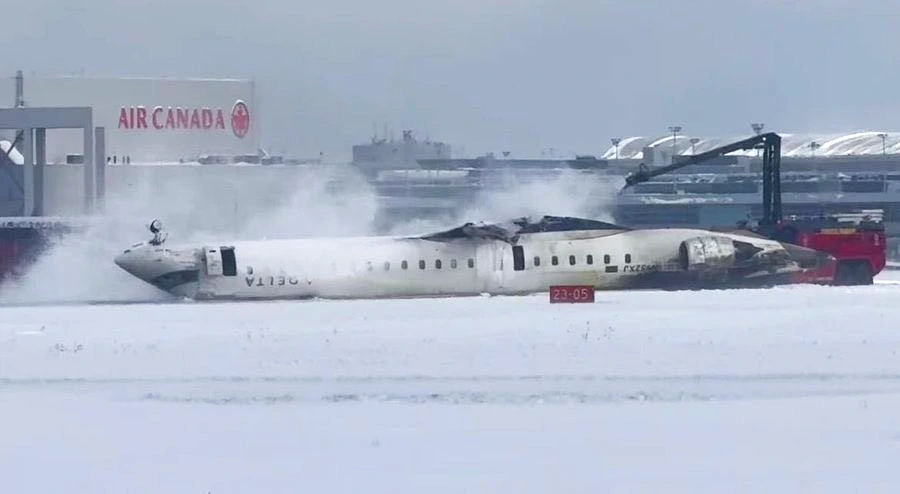Headlines
Delta Plane Overturns After Crash Landing at Toronto Airport

A Delta Airlines plane flipped upside down after a crash landing at Toronto Pearson Airport. Emergency crews responded swiftly, and investigations are ongoing.
A Delta Airlines regional jet, flight DL4819, overturned upon landing at Toronto Pearson Airport on Monday amidst a snowstorm and windy conditions.
The plane, managed by Endeavor Air, was arriving from Minneapolis-St. Paul International Airport carrying a total of 80 individuals: 76 passengers and four crew members.
The accident led to 18 people being injured, with three individuals, including a child, sustaining critical injuries. The rest were promptly taken to hospitals; however, 15 have already been discharged according to Delta’s statement.
The 16-year-old CRJ900, manufactured by Canada’s Bombardier (BBDb.TO) and powered by engines from GE Aerospace (GE.N), has a seating capacity of up to 90 passengers. Following the accident, video footage revealed that at least one of its wings was no longer attached to the aircraft.
Canadian authorities announced they would investigate the cause of the crash, which remains unknown at this time.
John Nelson, a passenger, shared a video on Facebook capturing the aftermath of the incident. The footage shows a fire engine spraying water on an overturned plane resting on the snow-covered tarmac.
He later told CNN that there had been no signs of anything out of the ordinary before landing.
“We hit the ground, turned sideways, and then ended up upside down,” Nelson told the television network.
“I managed to unbuckle myself and kind of fall, pushing my way to the ground. Some people were hanging and needed assistance getting down, while others could manage it on their own,” he said.
Weather Conditions
Earlier on Monday, Toronto Pearson Airport announced that it was contending with strong winds and freezing temperatures as airlines worked to recover from missed flights following a weekend snowstorm that left over 22 cm (8.6 inches) of snow at the airport.
According to FlightRadar24 data, the Delta aircraft landed in Toronto at 2:13 p.m. (1913 GMT) following an 86-minute flight and stopped near the junction of runway 23 and runway 15.
The flight tracking website reported that at the time of the crash, there were “gusting crosswinds and blowing snow” according to weather conditions.
Toronto Pearson Fire Chief Todd Aitken stated late on Monday that the runway was dry and there were no crosswind conditions. However, several pilots interviewed by Reuters who had seen videos of the incident disputed this statement.
John Cox, a U.S. aviation safety expert and pilot, mentioned that there was an average crosswind of 19 knots (22 mph) from the right during landing. However, he pointed out that this figure represents an average value and gusts would fluctuate accordingly.
He mentioned that due to the gusty conditions, pilots will need to frequently adjust their air speed as well as make modifications to both the vertical and lateral profiles. He added that this is a normal part of what professional pilots do.
Cox stated that investigators would attempt to determine the reason behind the detachment of the right wing from the plane.
Michael J. McCormick, an associate professor of air traffic management at Embry-Riddle Aeronautical University, stated that the upside-down position rendered the Toronto crash quite unique.
He stated, “The survival of 80 people in such an event highlights the strength of engineering and technology, as well as the regulatory framework that supports systems allowing individuals to endure situations which would have been fatal not too long ago.”
Three earlier incidents of planes flipping during landing involved the McDonnell Douglas MD-11 model. In 2009, a FedEx cargo plane overturned upon landing at Tokyo’s Narita airport, resulting in the deaths of both pilots. Similarly, in 1999, a China Airlines flight flipped over in Hong Kong and led to three fatalities among its 315 passengers. Additionally, back in 1997, another FedEx freighter experienced a flip at Newark without any loss of life.
Flight Delays
Flights have recommenced at Toronto Pearson; however, airport president Deborah Flint noted on Monday evening that some operational disruptions and delays are expected over the next few days due to two runways remaining closed for investigation.
She credited the lack of fatalities partially to the efforts of first responders at the airport.
“We are extremely thankful that there were no fatalities and only minor injuries,” she stated at a press conference.
The Transportation Safety Board of Canada (TSB) announced it is sending a team of investigators, while the U.S. National Transportation Safety Board has stated that its own team will support Canada’s TSB in this effort.
According to global aviation standards, a preliminary investigation report must be published within 30 days following an accident.
Japan’s Mitsubishi Heavy Industries (7011.T), which completed the purchase of Bombardier’s CRJ aircraft program in 2020, announced that it is aware of the incident and will fully cooperate with the investigation.
The crash in Canada occurred after a series of recent incidents in North America. In Washington, D.C., an Army helicopter collided with a CRJ-700 passenger jet, resulting in 67 fatalities. Meanwhile, at least seven people lost their lives when a medical transport plane went down in Philadelphia and another tragic accident claimed the lives of ten passengers aboard a flight that crashed in Alaska.
